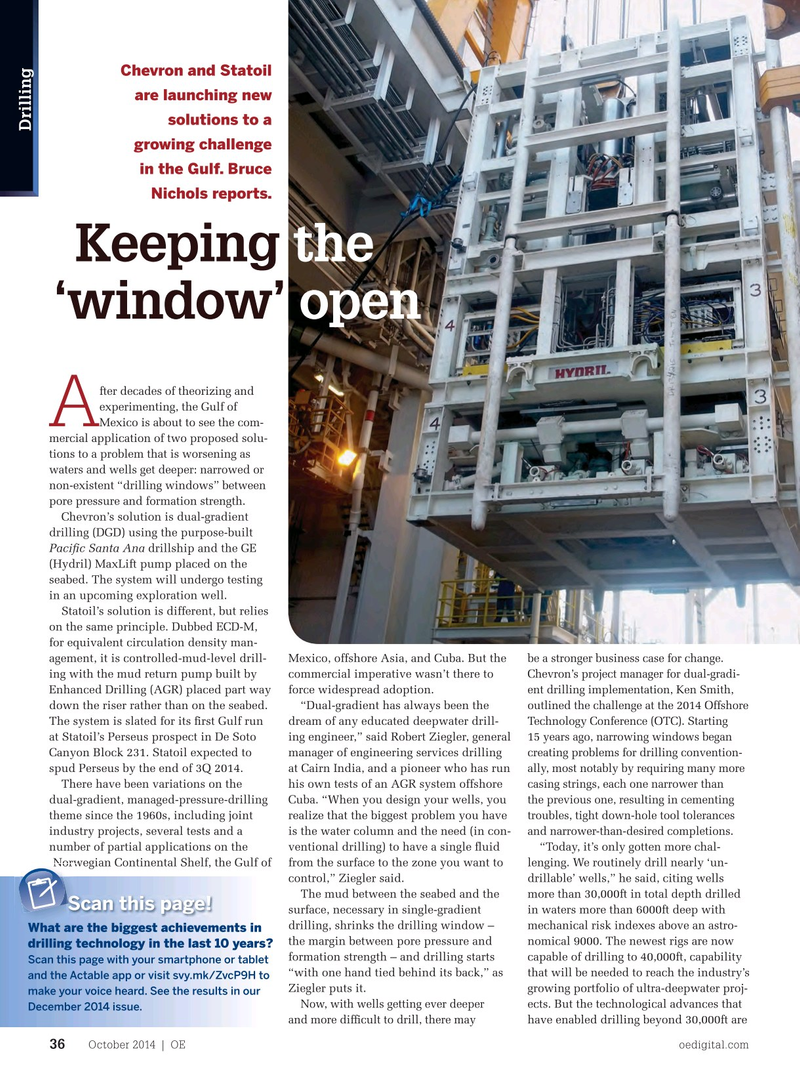
Page 34: of Offshore Engineer Magazine (Oct/Nov 2014)
Read this page in Pdf, Flash or Html5 edition of Oct/Nov 2014 Offshore Engineer Magazine
Chevron and Statoil are launching new solutions to a
Drilling growing challenge in the Gulf. Bruce
Nichols reports.
Keeping the ‘window’ open fter decades of theorizing and experimenting, the Gulf of
A
Mexico is about to see the com- mercial application of two proposed solu- tions to a problem that is worsening as waters and wells get deeper: narrowed or non-existent “drilling windows” between pore pressure and formation strength.
Chevron’s solution is dual-gradient drilling (DGD) using the purpose-built
Paci? c Santa Ana drillship and the GE (Hydril) MaxLift pump placed on the seabed. The system will undergo testing in an upcoming exploration well.
Statoil’s solution is different, but relies on the same principle. Dubbed ECD-M, for equivalent circulation density man- be a stronger business case for change.
Mexico, offshore Asia, and Cuba. But the agement, it is controlled-mud-level drill- less effective deeper down,
Chevron’s project manager for dual-gradi- commercial imperative wasn’t there to ing with the mud return pump built by he said. “We are nearing their ent drilling implementation, Ken Smith, force widespread adoption. Enhanced Drilling (AGR) placed part way limits to deliver today’s oil outlined the challenge at the 2014 Offshore “Dual-gradient has always been the down the riser rather than on the seabed. targets in deepwater,” Smith
Technology Conference (OTC). Starting dream of any educated deepwater drill- The system is slated for its ? rst Gulf run said. “It’s time to change the 15 years ago, narrowing windows began ing engineer,” said Robert Ziegler, general at Statoil’s Perseus prospect in De Soto game.” creating problems for drilling convention-
Canyon Block 231. Statoil expected to manager of engineering services drilling
Mud weight versus pore ally, most notably by requiring many more spud Perseus by the end of 3Q 2014. at Cairn India, and a pioneer who has run pressure, fracture gradient casing strings, each one narrower than
There have been variations on the his own tests of an AGR system offshore the previous one, resulting in cementing
Cuba. “When you design your wells, you dual-gradient, managed-pressure-drilling The basic problem is that the troubles, tight down-hole tool tolerances realize that the biggest problem you have theme since the 1960s, including joint weight of the drilling ? uid in and narrower-than-desired completions.
is the water column and the need (in con- industry projects, several tests and a the wellbore must stay within “Today, it’s only gotten more chal- ventional drilling) to have a single ? uid number of partial applications on the limits as the drill bit passes through vary-
Norwegian Continental Shelf, the Gulf of lenging. We routinely drill nearly ‘un- from the surface to the zone you want to Norwegian Continental Shelf, the Gulf of ing geologic strata on its way to target drillable’ wells,” he said, citing wells control,” Ziegler said. depth. If the mud weight is too heavy, it more than 30,000ft in total depth drilled The mud between the seabed and the can fracture a formation and cause col-
Scan this page!Scan this page!Scan this page!
in waters more than 6000ft deep with surface, necessary in single-gradient lapse of the wellbore as mud ? ows out mechanical risk indexes above an astro- drilling, shrinks the drilling window – into the neighboring strata, a phenom-
What are the biggest achievements in nomical 9000. The newest rigs are now the margin between pore pressure and enon called “losses.” If the mud is too drilling technology in the last 10 years? capable of drilling to 40,000ft, capability formation strength – and drilling starts light, it can’t prevent uncontrolled intru-
Scan this page with your smartphone or tablet that will be needed to reach the industry’s “with one hand tied behind its back,” as sion of water, oil or gas into the wellbore, and the Actable app or visit svy.mk/ZvcP9H to growing portfolio of ultra-deepwater proj- Ziegler puts it. a phenomenon called “kicks.” make your voice heard. See the results in our
Now, with wells getting ever deeper ects. But the technological advances that If mud weight becomes too heavy or too
December 2014 issue.
and more dif? cult to drill, there may have enabled drilling beyond 30,000ft are light, as the well deepens from one strata
October 2014 | OE oedigital.com 36 000_OE1014_D&C1_Bruce.indd 36 9/23/14 1:16 PM

 33
33

 35
35